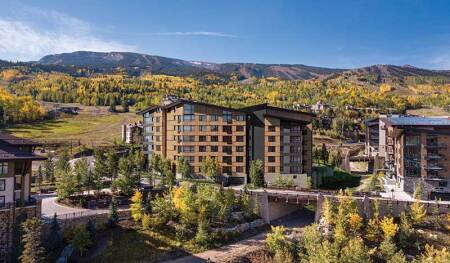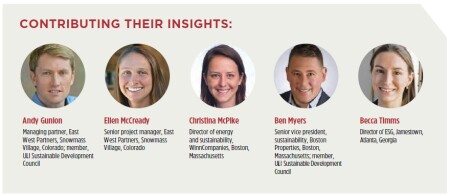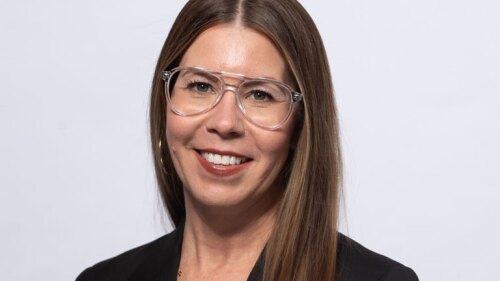
Electric Pass Lodge, a ski-in/ski-out condominium building under construction at the base of the Snowmass Ski Area in Colorado’s Snowmass Base Village, is designed to be 100 percent powered by renewable energy, including a rooftop solar array and electricity from the local utility’s off-site renewable sources. A tight building envelope, a passive cooling system, and a heat recovery ventilator help reduce electricity costs. Denver-based firms 4240 Architecture and River + Lime designed the building for East West Partners of Avon and Denver, Colorado. (Courtesy of 3DQ .studio)
How will the real estate industry navigate the transition to all-electric buildings?
Experts discuss best practices for incentivizing property owners and developers to switch to all-electric buildings, ways to ensure the transition is equitable for low-income communities, challenges to the widespread implementation of building electrification, and other innovations and trends.
What best practices should the public sector follow to incentivize building electrification in existing buildings as well as new construction?
Christina McPike: The public sector should consider both carrots and sticks to encourage building electrification. Sometimes the carrots, or incentives, are not as effective as the sticks—codes and policies. Policies, mandates, and possible financial penalties move the market. However, we need to avoid unfunded mandates. Public policy should educate the industry and the marketplace, offer technical assistance and training, and help with workforce development. Most importantly, we need to deliver adequate rebates, incentives, and no-interest long-term debt to get projects funded because electrification in existing buildings is very expensive.
Ellen McCready: Electric conversion of existing buildings will not be easy or cheap. First off, education is essential. Property owners need to understand the fundamentals of why electrification is beneficial to the climate and the health of building occupants. Then, significant financial incentives such as tax credits, rebates, and beneficial financing mechanisms will need to be offered to incentivize electric retrofits of existing buildings. Lastly, the public sector can implement electrification requirements as a condition of remodel projects. As with new construction, building envelope enhancements should be closely considered along with electrification.
Becca Timms: Collaboration with owners and end users is crucial before the public sector adopts any codes, policies, or incentives related to environmental, social, and governance goals. It’s important to understand the challenges faced by those who live and work in these buildings every day. Our ability to upgrade major building systems and disrupt tenant spaces depends on business plan and lease cycles. For example, at Levi’s Plaza in San Francisco, we’re converting four buildings from natural gas boilers to an all-electric heat pump solution. For such projects, we try to take advantage of vacancies, but we must also consider supplemental heating for tenants who remain. In some cases, we had to put a temporary boiler on the roof because there was no room inside or the load was too heavy. These projects require careful planning.
Ben Myers: First, highlight demonstration projects. There are more of these projects in warmer climate zones like the West Coast but fewer in colder climates where building electrification is more challenging. Second, strengthen utility rebate programs for heat pumps, insulation, and building envelope improvements. State programs for rooftop solar are also necessary to offset the increase in electricity use, particularly in jurisdictions with high electricity costs. Third, cultivate the workforce required to execute electrification projects. There is an aging workforce of electricians and tradespeople. Electrification will result in growing demand for skilled trades. A scarcity of qualified labor to fill new green jobs is a likely electrification constraint.
What needs to be done to ensure that electrification is improving social equity and benefiting low-income communities?
Andy Gunion: The primary purpose of building electrification is to mitigate the impact of the built environment on the global climate. Everybody on the planet naturally benefits from this movement. There are also potential health benefits to living in an all-electric building, so incentives should be provided to electrify new and existing affordable housing projects. With the right incentives, affordable housing could become an industry leader in building electrification. Building electrification should always be combined with ultra-efficient envelopes and other technologies to minimize the amount of electricity needed. This will reduce the ongoing utility cost burden for the residents.
Myers: First, programs and rebate incentives should target low-income communities, spreading awareness of the opportunity to electrify. Second, provide low-income communities with low- or zero-interest-rate loan programs. Third, bundle incentives that also improve the thermal envelope, such as insulation and windows, and encourage rooftop solar in tandem with the electrification of HVAC systems to reduce the operating cost burden for low-income community members. Fourth, target these same communities for workforce development programs, creating well-paying jobs for a just transition. The transition to a low-carbon economy will be a huge job creator. The pathways to low carbon can be pathways to prosperity for underserved community members.
McPike: WinnCompanies is a multifamily property owner and manager, primarily of affordable and mixed-income housing. Our residents are mostly low- and moderate-income individuals and families.
Therefore, everything we do supports low- and moderate-income communities. The public sector has done a good job of emphasizing environmental-justice communities and low-income populations more broadly. We see that play out nationally in the Inflation Reduction Act and, in Massachusetts, with the LEAN Multifamily Program, which should be a national model for how to incentivize energy efficiency. We need smart policies and programs with special setasides and bonus enhancements designed specifically for affordable housing. Although the details are still to be determined, bonus investment tax credits for solar and battery storage installed in low-income communities, for example, can make a big difference in equitable electrification.
Timms: Factors to consider when it comes to residential applications include one-time costs, ongoing electric costs, and indoor air quality. I’ve heard that induction cooktops may have a slightly higher one-time cost, both for residential and commercial applications. Additionally, compatible pots and pans are needed for induction cooktops. Some developers provide them to tenants as move-in gifts to reduce the financial burden. In terms of ongoing electric costs, those vary widely by region. In Georgia, we have a very high energy burden—the percentage of gross household income spent on energy costs. Therefore, it’s important to consider utility-bill relief programs or other incentives for households that are struggling.
The biggest driver for me is the indoor air-quality benefit. There are costs associated with an all-electric conversion, but on the other hand, there are probably costs related to gas cooking that are not fully visible. For example, high rates of respiratory disease, especially for children, are statistically proven to be tied to smoky indoor environments that often arise during gas cooking.
What do you feel is all too often left out of the conversation about building electrification?
Timms: For commercial applications, building electrification and kitchen electrification can increase electricity use, which can require costly upgrades to the utility service. Therefore, it’s important to start with building efficiency. For example, in retrofitting Levi’s Plaza, we were able to improve efficiency throughout the site. That allowed us to complete a boiler–to–heat pump conversion without having to upgrade the utility service. Other demands for electrical service, such as electric vehicle charging stations, need to be taken into account, as well. And it’s important to involve chefs and restaurateurs and get them on board. Once the chef is educated, it’s possible to optimize the menu, staffing, scheduling, and overall environment and find cost savings in other areas to offset the initial upfront equipment cost.
McPike: Across our portfolio, heating and hot water are typically produced by burning fossil fuels. When we talk about building electrification, we mean converting our heat and/or hot water from gas to electricity. While a heat pump may be three times more efficient than a gas furnace, electricity could be five times more expensive than gas. We focus on the upfront capital expense, but we don’t always consider the operational cost—i.e., if people can afford their electric bills after their buildings are electrified. This is one reason why energy efficiency is so important [to consider] before electrifying. We also need better strategies for electrification when converting central systems to apartment-level systems, potentially transitioning heating costs from the owner to the resident. And lastly, we need to consider greening and modernizing our grid in order to actually reduce carbon emissions.
Myers: The grid modernization necessary to deal with wintertime peak demand in our electrical grid is often left out of the conversation. Utilities need to work with policy-makers and the real estate community to forecast and effectively plan for increased wintertime peak demand in colder climate zones. We are commencing a series of grid modernization workshops in Boston, including executive leadership from large power users, utilities, and the city of Boston to work through these very issues. Grid reliability was once an issue only a few real estate energy nerds were talking about; now it’s being discussed in boardrooms.
Gunion: [The] desired carbon mitigation impact from building electrification—and electrification in general—is entirely dependent upon sourcing clean electricity to power these buildings. If an all-electric building is served by a grid that relies on fossil fuels, then its ongoing carbon footprint could actually be worse than a gas-powered building. As such, the movement toward all-electric buildings absolutely must be accompanied by a large-scale greening of the grid. Absent this, the building electrification movement could actually take us backwards.
What other innovations, new technologies, or trends are you excited about in this arena?
Myers: I’m very excited about the Inflation Reduction Act and its incentives, particularly for ground-source heat pumps. A lot of focus has been on air-source heat pumps, which have lower coefficients of performance when the outdoor air temperature is low. That’s not so much an issue with ground-source systems that operate with higher coefficients of performance, even when it’s very cold outside. The drilling and infrastructure for ground-source heat pumps have historically been expensive. The Inflation Reduction Act offers tax credits that could make ground-source heat pumps a lot more economical for developers and property owners. That’s going to depend on workforce development, too, in order to prepare the drilling rigs and technicians and supply chains to deliver ground-source heat pump systems at scale.
Timms: Induction cooking has been around for a while, but for a while there were conductivity issues when cooking and you had to keep the pan on the actual cooktop, which made it challenging for certain methods of cooking. However, the technology has evolved, and now there are induction woks that allow the chef to remove the pan and cook the food properly.
McCready: There are a lot of smart, motivated, and innovative people working on creative solutions to reduce the carbon footprint of buildings. It feels like this whole movement is still just ramping up and approaching a mass-market tipping point. Our new residential buildings in Snowmass feature ultra-efficient building envelopes, triple-pane windows, phase-change ceiling mats, heat exchangers, earth tubes, wastewater heat recovery systems, and more. The goal is to use these technologies to first reducethe amount of power that the building requires. We then source that power through clean electricity provided by our local utility provider.
McPike: We just closed on a cooperative agreement with the [U.S.] Department of Energy’s Connected Communities program, which is focused on grid-interactive efficient buildings. We’re really excited to be starting this four-year research and development project focused on optimizing the interaction of distributed energy resources and technologies such as solar, battery storage, electric vehicles, smart thermostats, building management systems, and smart appliances to maximize energy and carbon savings while improving grid operations and resiliency. Battery storage and demand-charge management will be critical for keeping up with the rapid electrification of buildings.
RON NYREN is a freelance architecture and urban design writer based in the San Francisco Bay area.
Recent Outlooks from Urban Land:
Related ULI Resources:





![ULI C Change [43].jpg](https://cdn-ul.uli.org/dims4/default/ff0f209/2147483647/strip/true/crop/1600x899+0+0/resize/500x281!/quality/90/?url=https%3A%2F%2Fk2-prod-uli.s3.us-east-1.amazonaws.com%2Fbrightspot%2F13%2Fe9%2F44fc920846a5829677f23a2fb93d%2Fuli-c-change-43.jpg)

